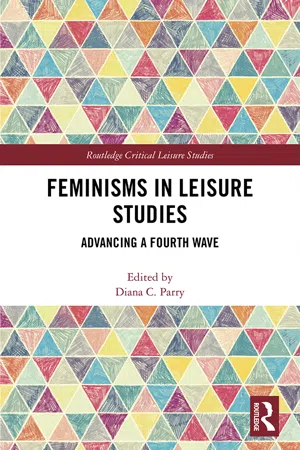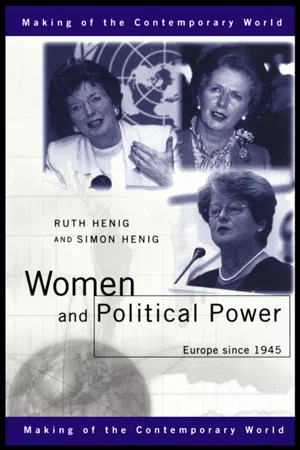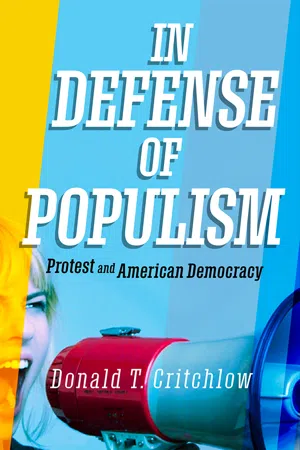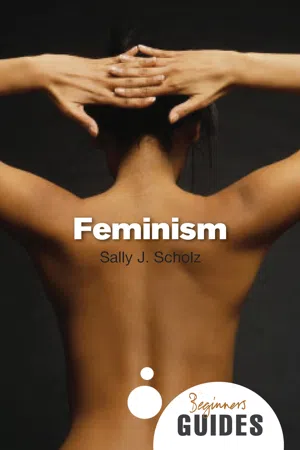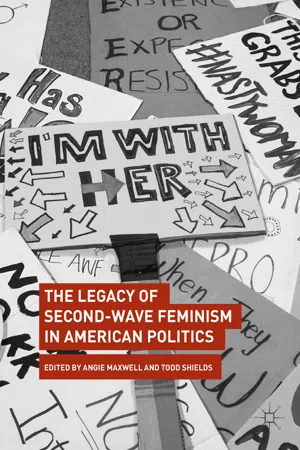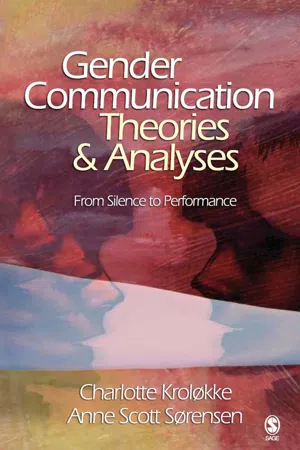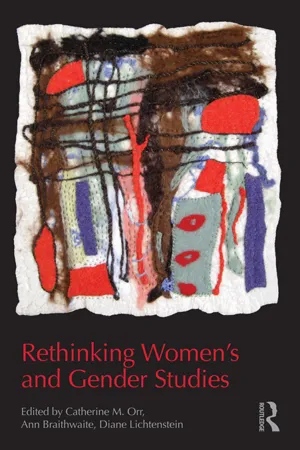History
Second Wave Feminism
Second Wave Feminism refers to the feminist movement that emerged in the 1960s and continued into the 1980s, focusing on issues such as reproductive rights, workplace equality, and sexual liberation. It sought to address the systemic inequalities and discrimination faced by women, advocating for social and political change. This wave of feminism also emphasized the importance of intersectionality and inclusivity in addressing women's rights.
Written by Perlego with AI-assistance
Related key terms
8 Key excerpts on "Second Wave Feminism"
- eBook - ePub
Feminisms in Leisure Studies
Advancing a Fourth Wave
- Diana Parry(Author)
- 2018(Publication Date)
- Routledge(Publisher)
Taken together, the possibilities and problematics of the wave metaphor demonstrate its strengths and weaknesses. To be sure, our decision to use the wave metaphor in this discussion is intentional. Aided by contemporary technological innovations like social media, feminism has returned to the realm of public discourse. The fourth wave of feminism is an everyday feminism. As the #TimHunt incident demonstrates, it is not a feminism accessible only to those in academia. To those on the frontlines, the wave metaphor remains the dominant conceptual tool for characterizing distinct moments in feminist thinking. In the spirit of this particular moment, then, we have chosen to appeal to the sensibilities of those on the frontlines and adopt the wave metaphor.History: from the first wave to contemporary conceptualizations of feminisms
The first wave of feminism largely focused on women’s suffrage. At the turn of the twentieth century, citizenship was gendered in most Western nation-states (Ramirez, Soysal, & Shanahan, 1997). In response, the women’s suffrage movement emerged with the aim of legally extending the category of personhood beyond men. In Canada, as similar to the US, following the protracted and disparate struggle to franchise groups of women across various racial (e.g., Indigenous, Asian) and geographic boundaries (e.g., Northwest Territories, Quebec), the collective movement re-emerged in the early 1960s when feminists began to rally around issues of abortion, sexuality, motherhood, and labour rights (Shugart, 2001). During this period, Gloria Steinem and Betty Friedan were key feminist leaders in North America, and their visibility helped define what is known as the second wave of feminist action.While the second wave worked to highlight many inequities, the knowledge generated during this period was not representative of all women’s lived experiences. As noted by hooks (2000), the second wave of feminism was a largely liberalist movement focused on advocating issues mostly relevant to the lives of White, middle-class, heterosexual women. In this context, second wave scholarship often overlooked difference and excluded women of diverse ages, ethnic identities, sexualities, socio-economic status, as well as men (Dean, 2009). Based on its exclusions, the second wave is viewed by some as judgemental, inflexible, and divisive (Braithwaite, 2002; Snyder, 2008; Snyder-Hall, 2010).Unlike the second wave, there is considerable debate as to when the third wave of feminism began. Contemporary feminists recognize an important moment when Rebecca Walker wrote an article for Ms magazine in 1992, which criticized the appointment of Clarence Thomas to the Supreme Court of the United States1 - eBook - ePub
Women and Political Power
Europe since 1945
- Simon Henig(Author)
- 2002(Publication Date)
- Routledge(Publisher)
3 Second Wave Feminism The 1970s and early 1980s The movement which has become known as ‘Second Wave Feminism’ emerged in several western European countries in the late 1960s. Whereas the first wave of feminist activity was principally concerned with gaining the right to vote, by the 1960s it was clear that women were still socially and politically disadvantaged. Thus, the term ‘Second Wave Feminism’ covers a whole variety of disparate organisations, groups and campaigns seeking to liberate women from what were perceived to be oppressive male structures and to promote genuine equality between the sexes. 1 There has been much discussion about the reasons why so many women became involved in women’s protest movements at this particular time. Clearly, the activism and feminist writings of women in the United States in the early and mid- 1960s inspired many women in Europe. 2 At the same time, peace campaigns like the Campaign for Nuclear Disarmament (CND) movement in Britain and the student protest movements of the later 1960s in many west European countries drew growing numbers of women into political activism. By the mid-1960s, women had increasing access to further and higher education. Alongside growing educational opportunities, the mass marketing of labour-saving devices reduced the amount of time which needed to be spent on housework, and the growing availability of contraceptives enabled women to control their fertility and to limit family size. Furthermore, the 1960s was a time of economic growth in western Europe, and increasing numbers of women, both married and single, were drawn into employment - eBook - ePub
In Defense of Populism
Protest and American Democracy
- Donald T. Critchlow(Author)
- 2020(Publication Date)
- University of Pennsylvania Press(Publisher)
4 Second-Wave Feminism, Social Protest, and the Rights RevolutionThe crescendo of postwar feminism gained intensity in the late 1960s and early 1970s, albeit with disconcerting dissonance within the movement’s ranks and among the general public. The aftermath of the movement continued to reverberate in American politics and culture, as more women were elected to office, entered the workforce and college, and demanded respect in gender relations. A huge infrastructure protecting women’s rights was created in government, corporate business, and colleges to ensure equal opportunity and action for advancement of women. A reasonable argument can be made that the feminist movement in this period—second-wave feminism—made the greatest gains for its cause than any other social movement in the postwar era.Estimating with any precision the relationship of cause and effect of social movements and sociopolitical gains is always difficult. Although second-wave feminism had roots in labor organizing in the 1940s and the early civil rights movement, feminism as a mass social movement did not take clear formation until the mid-1960s. Even before this, however, state courts and the U.S. Supreme Court had ruled in a number of significant cases advancing the rights of women. Congress enacted the Equal Pay Act of 1963 aimed at abolishing wage disparity based on gender, and in 1964 Congress included discrimination on account of gender in the Civil Rights Act. Leaders in both the Democratic and Republican parties understood the importance of winning women voters, which suggests that protecting women’s rights was going to advance with or without feminist social protest. There should be no doubt, however, that the feminist movement employed social protest to accelerate the advancement of women, and that this movement gained mass support—as well as conservative female and male reaction. - eBook - ePub
Feminism
A Beginner's Guide
- Sally J. Scholz(Author)
- 2012(Publication Date)
- Oneworld Publications(Publisher)
4Expanding the sphere of influence: the second wave
As we have seen, the first wave of feminist activism may be characterized by struggles to gain recognition of the legal, economic, social, and intellectual status of women. The second wave might be understood as trying to address all of those aspects of women’s oppressed experience that are not addressed once legal, economic, and intellectual equality are achieved. In part, this also means refining what we understand as equality but it also extends to women’s bodily experience in culture and society. Changing the laws prohibiting women from entering the workforce does not always change the way women are treated once they are part of that workforce. Granting women full rights of citizenship with the right to vote does not always mean that the specific concerns of women will be heard or that women will be taken seriously as participants in political life. By adding an analysis of oppression that extends to understandings of the body, morality, subjectivity, and identity, Second Wave Feminism allows additional means for understanding and combating oppression as well as further requirements for liberation.The Second SexThe woman most frequently credited with bringing in the second wave of feminism is Simone de Beauvoir (1908–1986). Beauvoir was one of the twentieth century’s leading intellectuals and her book, The Second Sex (1949), was an unprecedented study in the cultural myths, social standards, and life situations of women. She uses existentialism, a philosophical movement popularized in France in the twentieth century, to frame the question: ‘What is a woman?’Beauvoir develops an account of existential ethics in The Ethics of Ambiguity (1947), and uses that as her methodology in The Second Sex - Angie Maxwell, Todd Shields, Angie Maxwell, Todd Shields(Authors)
- 2017(Publication Date)
- Palgrave Macmillan(Publisher)
In this introductory chapter, Angie Maxwell and Todd Shields claim that the need to mark beginnings and endings of social movements, the over-reliance on popular, yet limited voices, the fact that feminism is not immune to white privilege, and the pain associated with lost battles for women’s rights have all contributed to obscuring the true legacy of the Second-Wave feminist movement. They contend that existing narratives have inordinately focused on the media-appointed “leaders” of the movement, who were almost exclusively white, heterosexual, well-educated women who overshadowed the multi-racial, grassroots cast of hundreds of thousands of women in America and around the globe. While Third-Wave feminists drew attention to these omissions and recovered the history of overshadowed communities, the time has come to reconcile both waves and re-examine the legacy of Second-Wave Feminism in American politics. This reassessment shows that the Second Wave was comprised of a heterogeneous army of women who, though often divided, still significantly influenced economics, theology, political activism, electoral success, attitudes toward homosexuality‚ and support for gay marriage. In fact, in many ways they were so successful that they were blind to the anti-feminist counterattack forming across the country. This introduction highlights the feminist historians, political scientists, gender studies scholars, and economists who are placing women’s activism at the center of our political landscape in their contributing chapters.The original version of the book was revised: Final corrections have been incorporated. The erratum to this chapter is available at https://doi.org/10.1007/978-3-319-62117-3_11End AbstractIn her edited collection, Feminist Coalitions: Historical Perspectives onSecond -Wave Feminismin the United States , Stephanie Gilmore speaks to the scholarly paralysis that has tempered our understanding of both the accomplishments and the failures, and of the structure and impact, of Second-Wave Feminism. Depicted most often as an offshoot of the Civil Rights Movement , Second-Wave feminists “are suspended in historical—or rather, ahistorical—amber, unable to move or be moved.”1Gilmore’s volume and its contributors did much to resurrect this debate. The paralysis, however, is not limited to the way in which the movement is conceived as branching from the larger fight for African-American rights, but also, as Sara M. Evans contends in Chap. 2 , to our proclivity to periodization. The need to mark a beginning and an end to what has been a sustained and constant effort for women’s equality—the need even to describe such periods as distinct “waves”—obscures much of the labor. And it obscures the laborers, many of whom remain absent from our narratives. Only popular leaders, or those leaders recognized by the media, present at key events highlighted by this periodization, remain in the public consciousness. Those leaders are almost exclusively privileged, white, and well-educated and function as the feature players overshadowing a multiracial, grassroots cast of hundreds of thousands of women in America and across the globe. And the movement itself, as the passage of a half-century has shown, lost control of the debate over women’s rights as the individual became more powerful than the collective. And so the united front needed to brace against the titanic backlash proved elusive. The consciousness-raising opened women’s eyes to their individual oppression, but not enough saw their own individual experience as part of a systemic and structural oppression for which political, collective, unified action remains the only antidote. Because the conservative backlash was so powerful, because the unity, despite the best efforts‚ was too fragile‚ because of our need to superficially mark beginnings and endings of social movements, because of our over-reliance on popular, yet limited voices, because feminism is not immune to white privilege- eBook - ePub
Gender Communication Theories and Analyses
From Silence to Performance
- Charlotte Kroløkke, Anne Scott Sorensen(Authors)
- 2005(Publication Date)
- SAGE Publications, Inc(Publisher)
1 Three Waves of Feminism From Suffragettes to GrrlsW e now ask our readers to join us in an exploration of the history of feminism or, rather, feminisms: How have they evolved in time and space? How have they framed feminist communication scholarship in terms of what we see as a significant interplay between theory and politics? And how have they raised questions of gender, power, and communication?We shall focus our journey on the modern feminist waves from the 19th to the 21st century and underscore continuities as well as disruptions. Our starting point is what most feminist scholars consider the “first wave.” First-wave feminism arose in the context of industrial society and liberal politics but is connected to both the liberal women’s rights movement and early socialist feminism in the late 19th and early 20th century in the United States and Europe. Concerned with access and equal opportunities for women, the first wave continued to influence feminism in both Western and Eastern societies throughout the 20th century. We then move on to the second wave of feminism, which emerged in the 1960s to 1970s in postwar Western welfare societies, when other “oppressed” groups such as Blacks and homosexuals were being defined and the New Left was on the rise. Second-wave feminism is closely linked to the radical voices of women’s empowerment and differential rights and, during the 1980s to 1990s, also to a crucial differentiation of second-wave feminism itself, initiated by women of color and third-world women. We end our discussion with the third feminist wave, from the mid-1990s onward, springing from the emergence of a new postcolonial and postsocialist world order, in the context of information society and neoliberal, global politics. Third-wave feminism manifests itself in “grrl” rhetoric, which seeks to overcome the theoretical question of equity or difference and the political question of evolution or revolution, while it challenges the notion of “universal womanhood” and embraces ambiguity, diversity, and multiplicity in transversal theory and politics. - eBook - ePub
- Catherine M. Orr, Ann Braithwaite(Authors)
- 2012(Publication Date)
- Routledge(Publisher)
Finally, the waves metaphor reinforces a Western and often English-speaking vision of feminism, based on the U.S., Canadian, and European contexts from which feminism’s wave structure emerged. “The common rhetoric of feminist ‘waves’,” writes Susan Stanford Friedman, “misleads in many ways. It is insufficiently global, in the first place, using the feminist movements in the West, especially Britain and the United States, as the defining periodization for all” (2002, 431). Friedman’s point is clearly visible in the ways in which “third wave feminism” is currently being used in various places around the world, particularly in Australia, Britain, Canada, and the United States. The concept of third wave feminism as it has developed over the last decade and half is a product of postindustrialized Western democracies that have experienced earlier periods—or waves—of feminist activism and that have led to at least some level of success in advancing the cause of gender equality. Central to this definition of the “third wave” is that it comes after an earlier period of women’s activism which is historically located in the 1960s and 70s.To provide an example of how third wave feminism is specific to postindustrialized Western democracies, we can turn to the case of Poland. In a recent article, feminist scholar Agnieszka Graffdescribes how the waves metaphor falls short in describing Polish feminism, which never experienced a women’s movement in the 1960s and 70s. Younger feminists today in Poland do not identify as third wave feminists since to do so would require a second wave against which to define themselves. Indeed, Graffdescribes contemporary Polish feminism as a combination of third wave modes of activism (the use of drag performance, for example) and second wave demands (reproductive rights and pay equity, in particular). As Graffwrites, “If we were to apply American chronology to this particular moment [in Poland], we would probably have to call it a third wave form for a second wave content in a backlash context” (2003, 103). - eBook - ePub
Postfeminisms
Feminism, Cultural Theory and Cultural Forms
- Ann Brooks(Author)
- 2002(Publication Date)
- Routledge(Publisher)
1 Consensus and Conflict in Second Wave Feminism Issues of diversity and ‘difference’ in feminist theorising DOI: 10.4324/9780203428894-1 Introduction This first chapter investigates feminism’s location at the intersection of modernity and postmodernity, and examines some of the debates which have been leading feminism towards a possible paradigm shift. As it confronts critiques from within and outside its own discourses, contemporary feminism is reassessing its epistemological foundations within modernism. This chapter considers some of these critiques and assesses the implications for feminist theoretical and political debates in the 1990s. Feminism, Modernity and Postmodernity Feminism has always engaged with the ‘master’ discourses with which it has found itself allied, whether they are the discourses of modernity or postmodernity. It cannot be denied that the theoretical frameworks and principles of operation which have characterised feminism have been the result of feminism’s intersection with these discourses, either the ‘metanarratives’ of modernity, e.g. Marxism, or the postmodernist and poststructuralist discourses of postmodernity. The relationship between feminism and modernity is not a straightforward one. Marshall (1994 :148) notes the relationship of women to modernity and to social theory as a modern project is one riven with contradictions and ambiguities. She claims that feminism ‘constitutes both a critique of and a defence of modernity, so has a great stake in the modernity-postmodernity debates which are at heart about the possibility of a “subject” for social theory’. The failure of theories of modernity for feminism has been their inability to come to grips with ‘difference’ adequately. Thus, on the one hand, as an emancipatory politics and a body of critical and political theory, feminism continues to use ‘egalitarian rhetoric as the basis of most of its political demands’
Learn about this page
Index pages curate the most relevant extracts from our library of academic textbooks. They’ve been created using an in-house natural language model (NLM), each adding context and meaning to key research topics.
